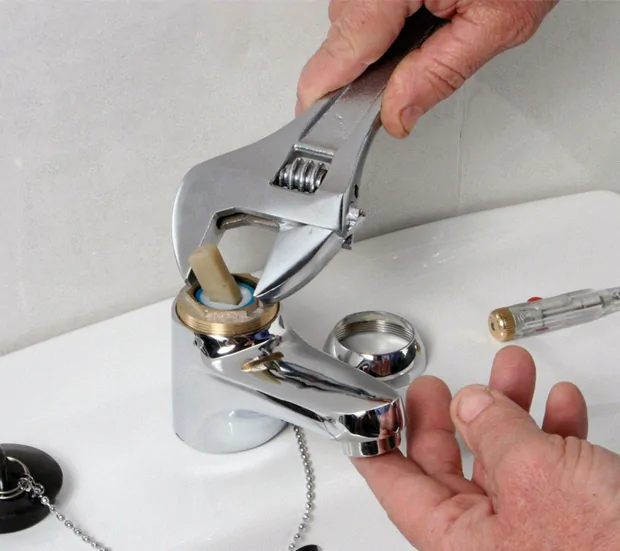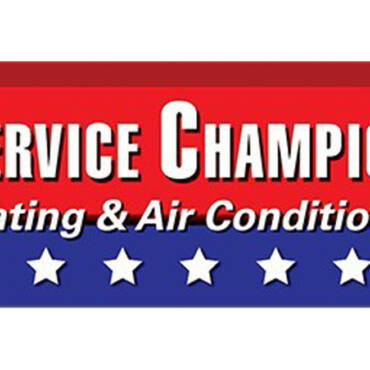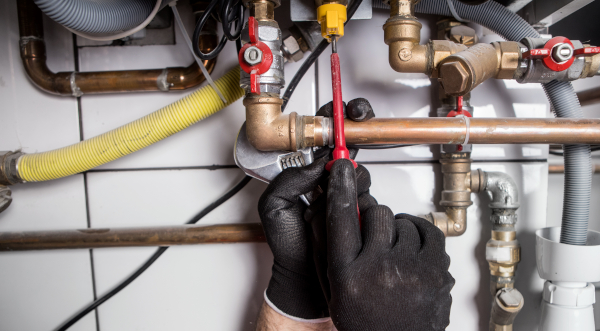You can’t beat the historic charm of Bucks, Montgomery and Chester counties. Loaded with 18th and 19th century homes that give you that warm, old-timey feeling the second you lay eyes on them. Who doesn’t love the vintage vibe of those classic Colonials and Victorians lining main streets like State and Baltimore Pike? It’s like taking a step back in time.
But here’s the reality – owning an older gem around these parts often means inheriting some seriously outdated plumbing headaches too. Those original cast iron and galvanized pipes were never meant to last over 100 years! What seems quaint and cozy at first can turn into a real nightmare of constant clogs, water pressure issues and even burst pipes if you’re not careful.
Before you get stars in your eyes over wide-plank floors and classic millwork, it’s important to be realistic about the potential plumbing problems lurking behind the walls. This guide will give you the full rundown on common drain disasters, corroded pipes, bellied sewers and other aging plumbing woes found in vintage local homes. From tree root invasions to failing fixtures, you’ll definitely want to have a good plumber on speed dial! But don’t worry, we’ve also got plenty of tips for keeping those antique plumbing systems going strong.
Aging Pipes and Materials
When it comes to plumbing pitfalls in older local homes, the pipes themselves are often public enemy number one. The materials they used back in the day just weren’t built to last like modern stuff.
Cast Iron and Galvanized Pipes
These heavy metal pipes were the go-to for houses built before the 1960s. And while they seemed solid at first, decades of constant water exposure causes major corrosion and rust issues over time. That mineral buildup on the inside steadily decreases water pressure and flow until your pipes are basically useless. Cast iron is also prone to cracking and leaking as it ages – nothing a little flex seal can’t fix, right?
Lead Pipes
This one’s more than just an inconvenience – lead pipes can pose a serious health hazard if they leach into your drinking water. Many homes constructed before 1986 used lead for their water lines, so there’s a good chance your vintage abode has some lingering lead issues. Telltale signs include a metallic taste, stained fixtures, and basic testing can confirm it. Don’t mess around with potential lead contamination – get those pipes replaced ASAP if they test positive.
The reality is those aging metal pipes simply can’t hold up forever without replacement. From rust-choked galvanized lines to hazardous lead, outdated plumbing materials are often the biggest culprit behind recurring clogs, leaks and other headaches in old houses.
Outdated Plumbing Fixtures
But aging pipes aren’t the only vintage plumbing problems you’ll face in an older home around here. Those antique sinks, toilets and faucets can be just as much of a headache!
Worn-Out, Leaky Relics
Decades of constant use really take a toll on plumbing fixtures. Those old sinks and toilets were built to last, but not literally last forever without replacement. Mineral buildup, corrosion, and just plain wear-and-tear cause annoying leaks, clogs and inefficiency over time. Forget about any modern water-saving features too – antique fixtures just guzzle away gallon after gallon.
Hard-to-Find, Outdated Components
Here’s another fun issue with outdated bathroom and kitchen fixtures: Finding replacement hardware and components is next to impossible these days. Manufacturers stopped making parts for those fossil models ages ago. So if your 1930s toilet tank cracks or the 50-year-old faucet handle shears off, you’re in trouble unless you can track down an obscure vintage supplier.
Bottom line – those old school plumbing fixtures may have historic charm, but they’ll also give you a constant stream of headaches and inefficiencies that new stuff simply doesn’t. From constant leaks and clogs to sky-high water bills, outdated sinks and toilets make owning an older home way harder than it needs to be. Definitely be prepared to budget for some big remodeling projects!
Low Water Pressure
Weak shower stream got you going night-night before you can even rinse the shampoo out? Faucets that basically just trickle these days? Low water pressure is one of the most frustrating – and common – plumbing problems in older homes.
Crusty Pipes to Blame
In most cases, that sad lack of pressure is thanks to those aging, corroded pipes we talked about earlier. Years of mineral buildup from hard water creates nasty obstructions inside the lines that choke water flow. Rusted out galvanized pipes only make matters worse as the interiors get narrower and narrower over time. Sometimes it’s a localized clog causing low pressure in just one sink or bathroom. But scalding hot showers that turn to cold trickles? That’s a sign of some serious system-wide blockage going on.
Bring on the Power!
The quick fix for low pressure is often installing a water pressure booster – basically a pump that forces more flow through your pipes. But that’s really just a band-aid solution if the underlying issue is major corrosion and buildup inside those old pipes. For a true permanent fix, you’ll probably need to bite the bullet and get a full re-pipe job done by a professional plumber. It’s an investment, but well worth it to finally enjoy decent water pressure again!
Low flow is just par for the course when you’re living with antiquated plumbing. From mineral-choked pipes to failing fixtures, weak water pressure makes basic tasks like showering and washing dishes a constant struggle in older homes. Don’t resign yourself to that dribble – have a plumber inspect and repair the root cause!
Drainage Problems
Okay, so maybe your water pressure is actually decent, but it’s still a struggle to get anything to drain efficiently. Sluggish, clogged up drains are yet another plumbing woe that plagues older homes around here.
Old or Improperly Installed Sewer Lines
A lot of drainage disasters stem from those aging main sewer pipes running underground. We’re talking lines installed back in the 1950s or earlier using materials that just weren’t meant to withstand decades of abuse. Tree roots are the biggest culprit, invading and cracking those antique terra cotta or cast iron pipes over time. Next thing you know, sewage is backing up into your basement or yard because the whole line has collapsed.
Outdated Drain Systems
Even the pipes inside your home may be woefully outdated and undersized for modern living. Bathrooms and kitchens built with just 1.5″ drain lines back in the day quickly get overwhelmed by today’s higher household volumes. Smaller pipes equal slower drainage and more frequent clogs from all that hair, food scraps and soap scum buildup. It’s a challenge to get that bathtub to drain properly!
The reality is most older plumbing systems simply weren’t designed for the demands we put on them nowadays. Constant backups and overflowing drains are the unfortunate result. Replacing failing sewer lines, upsizing undersized pipes, and installing preventative measures like backflow valves are often necessary upgrades. Otherwise, you’ll just be dealing with flooded basements and blocked sinks on a weekly basis. Not a great time!
Water Heater Issues
Speaking of not being designed for modern living – let’s talk about those ancient water heaters lingering in older home basements. They may have gotten the job done back in the day, but it can’t keep up with your family’s hot water demands these days!
Efficiency? What’s That?
Water heaters from the 70s, 80s or even 90s are basically energy sieves compared to new models. Adding those insulation blankets helps a little, but those antique tanks are still major power guzzlers. With efficiencies as low as 50% or less, you’re paying an arm and a leg just to heat water that gets wasted through constant standby heat losses. No wonder your energy bills are through the roof every month!
Constant Cold Showers
Older water heaters also tend to be woefully undersized for the amount of hot water modern households require. Having more than one bathroom, running the dishwasher, and doing laundry can quickly drain those puny 30 or 40 gallon tanks bone dry. Cue the freezing cold mid-shower wake up calls as the hot water suddenly runs out! There’s nothing quite like getting an unexpected ice bath.
Rusty Nasties
As if that’s not bad enough, sediment buildup from years of hard water takes a major toll too. All those minerals settling in the tank create nasty rust that can corrode right through the unit over time. Next thing you know, you’ve got a waterfall in the basement from a busted, leaky water heater. That’s gonna require a pricey replacement real quick!
If your tank is pushing 15 years old and you’re sick of sky-high bills, cold showers, funky rust-tinted water, and lukewarm dishwater, it’s definitely time to replace that dinosaur. Today’s high-efficiency tankless models or hybrid heat pump units are a world more efficient and can easily meet even the biggest household’s hot water demands. Upgrading won’t be cheap upfront, but it’ll pay off big time in energy savings and endless hot water bliss!
Leaky Pipes and Fixtures
Of course, we can’t talk about plumbing pitfalls in older homes without addressing the dreaded leak issue. Incessant leaks are very annoying for any homeowner. Leaks are just par for the course when you’re dealing with vintage plumbing.
Worn-Out Seals and Joints
A lot of those pesky drips originate from failed seals and joints that have simply gotten old and cracked over decades of use. Faucet gaskets, valve packings, supply line connectors – they were never built to last 50, 60, 70 years! Even the slightest hairline crack is an open invitation for water to escape.
Hidden Moisture Monsters
While a drippy faucet is annoying, the real nightmare leaks are the ones you can’t see. Pinholes and cracks in pipes hidden behind walls or under floors can allow moisture to steadily seep out undetected for months or years. By the time you notice, you could already have a major mold issue or rotted wood framing from all that water damage. Yikes!
Sniff It Out Early
The earlier you detect leaks, the better. Do periodic checks around pipe penetrations, under sinks, and near fixtures for any dampness, staining, or mineral deposits. Use that nose too – if you pick up any musty, mildew-y scents, it could mean hidden moisture. Catching leaks when they’re still minor drips can prevent thousands in repair costs down the road.
Leaks are just an unavoidable reality as plumbing systems age and components fail. From corroded pipes to worn-out fixture gaskets, there’s always a new drip waiting to strike in older homes. Staying vigilant about detecting moisture issues early is key to avoiding major damage. Otherwise, you’re just waiting for the next mold explosion or flooded basement disaster!
Tips for Maintaining Plumbing in Older Homes
Dealing with all those aging pipes, outdated fixtures, and stubborn clogs is just par for the course when you own an older home around here. With some smart maintenance habits, you can stay ahead of issues and maximize your vintage systems.
Get on a Routine Inspection Schedule
Having a professional plumber scope out your pipes and plumbing components annually is a wise investment. Their trained eyes can spot potential issues like corrosion, bellied pipes, or failing fixtures before they turn into a total disaster. Routine drain cleaning helps prevent clogs from building up too. Catching problems early allows you to plan and budget for upgrades, rather than scrambling for an emergency repair.
Upgrade Things Gradually
Let’s be real – replacing every last bit of an old home’s plumbing at once just isn’t feasible for most budgets. But you can upgrade things room-by-room or section-by-section as needed and as funds allow. Swap out the oldest, leakiest fixtures first. Or have your main sewer line replaced this year, then focus on repiping the bathrooms down the road. Taking it one step at a time makes that plumbing overhaul way more manageable.
Show Your Pipes Some Care
While you’re waiting to replace components, some basic care can help extend the life of existing pipes and drains. Using a water softener cuts down on that mineral buildup that clogs lines over time. Flushing drains regularly with baking soda and vinegar helps dissolve gunk. And quickly repairing even minor leaks prevents excessive moisture damage. Simple maintenance goes a long way!
Saying Bye to Plumbing Woes
At the end of the day, a little proactive plumbing care goes a long way in older Bucks, Montgomery, and Chester County homes. From repiping projects to new high-efficiency water heaters, Christian has you covered. We have been setting the highest standards in the industry since 1989, and we offer top-notch services and products you can trust. Our crew is committed to customer service and quality workmanship that sets the industry standard. This is what gained our customer’s trust all these years!
Don’t resign yourself to another day of drippy faucets, clogged drains, or icy showers. Call Christian at (215) 488-5795 to schedule an inspection or upgrade. We’ll get your vintage plumbing whipped into shape and keep it running smoothly for years to come!
Whether you require installation, repair, or maintenance, our technicians will assist you with top-quality service at any time of the day or night. Take comfort in knowing your indoor air quality is the best it can be with MOE heating & cooling services Ontario's solution for heating, air conditioning, and ventilation that’s cooler than the rest.
Contact us to schedule a visit. Our qualified team of technicians, are always ready to help you and guide you for heating and cooling issues. Weather you want to replace an old furnace or install a brand new air conditioner, we are here to help you. Our main office is at Kitchener but we can service most of Ontario's cities
Source link



